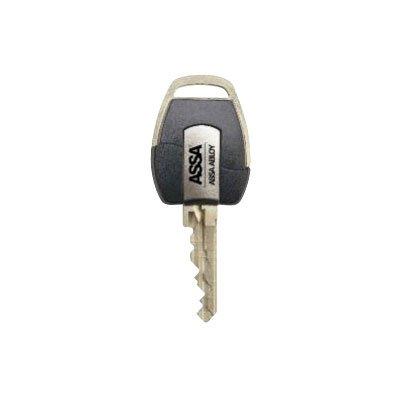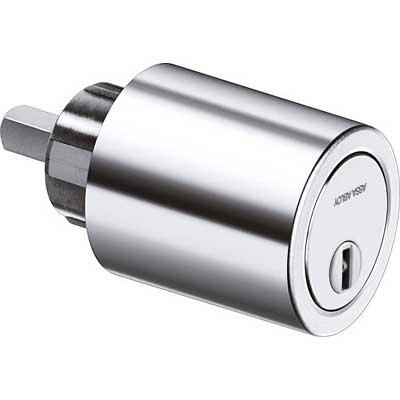ASSA ABLOY - CLIQ

ASSA ABLOY - CLIQ Overview:
CLIQ® – Mechatronic locking system
CLIQ® is a security locking system with high-end microelectronics, programmable keys and cylinders. The system offers a variety of combinations of mechanical and electronic systems to match different security and flexible access needs.
Available on the global marketplace, it provides flexible access and key management solutions for all kinds of locking applications.
A wire-free system, each key can be programmed and updated individually to allow access to specific areas at specific times and dates, accommodating constantly changing access requirements and ensuring maximum flexibility.
The power is provided by a battery inside the programmable CLIQ® key.
ASSA ABLOY - CLIQ news
Security at healthcare premises has never been higher on the agenda. Patients expect safety and privacy. Yet many medical locations must be open and accessible around the clock. The protection of drugs, vaccines, equipment and data makes it critical to know who accesses where, and when. Mechanical lock-and-key security was not designed to meet these challenges. Wireless locking devices provide the easiest upgrade or replacement for any access system based on mechanical or magnetic locks. Smartcards, programmable keys or secure mobile keys stored on a smartphone can replace cumbersome physical keys. Online locking systems When access control extends throughout a hospital, healthcare professionals waste less of their valuable time searching for the right key. A personalised credential is pre-programmed to open every door, lock or store they need to access. A personalised credential is pre-programmed to open every door, lock or store they need to access For building managers and healthcare agencies, wireless devices make it cost-effective to add electronic control to many more areas of a building. With online locking systems, facility managers monitor and manage premises in real-time, viewing the status of doors, medicine cupboards and server racks from one software interface. Physical key management Example #1: Upgrading to intelligent physical keys - Physical key management can hinder patient care, as pharmacy nurses at the UK’s Queen Elizabeth Hospital, Birmingham discovered. An older, mechanical system made it difficult to find who held the right keys for medicine stores. Nurses were wasting valuable time searching. Managers identified a better solution: CLIQ® electromechanical locks. With CLIQ, power to each access control lock is supplied by a standard battery inside every key. No wires are required, so this is an easy retrofit solution for doors, cabinets and drug trolleys. Each employee carries one programmable key to open all authorised locks. “The message from nursing staff is that patients are getting medicines much easier and in a more timely fashion,” says Inderjit Singh, Chief Pharmacist at QE Birmingham. “For us, the key return on investment is the quality of service we’re providing.” Swapping mechanical lock The hospital added secure doors without excessive installation or operating costs Example #2: Integrating hardware to extend access control - Swapping a mechanical lock for a battery-powered device can link another door to an existing access control system. It instantly upgrades security for sensitive offices and drug stores. At the Haute Savoie region’s new hospital, managers selected Aperio locking integrated online with an ARD security system. Because Aperio locks are wireless and integrate easily with any access system, the hospital added secure doors without excessive installation or operating costs. Staff no longer waste time hunting down keys. “Having just a single badge — and not having to carry around heavy keys — has been a major advantage,” says Béatrice Dequidt, Health Executive at CHMS. “We have implemented internal HR management procedures, creating badges that are automatically integrated into ARD's operating software,” adds Alain Gestin, CHMS’s IT Systems Architect. Access control system Example #3: Mobile keys to reducing shared touchpoints - Multiple key systems; varied openings including fire doors, glass doors, offices, pharmacies, car parks and lifts; hundreds of workers and contractors whose access permissions constantly change. Faced with these challenges, Hospital MAZ, in Zaragoza, upgraded their mechanical locking to a new SMARTair Wireless Online electronic access control system. Because SMARTair Wireless Online updates in real-time via communications hubs, security managers handle everything from the central system. Staff and contractors carry a single smartcard ID, programmed with individual permissions Staff and contractors carry a single smartcard ID, programmed with individual permissions. At any time, hospital managers can upgrade to SMARTair Openow mobile access without changing lock hardware. This option offers contactless entry for employees, who keep mobile keys updated on their own smartphones. "We have achieved all our objectives with the installation of the system,” says Miguel Angel Hernández Jerez at Hospital MAZ. Electronic PIN lock Example #4: Door security without software - In any busy medical facility, it is easy to leave a door unlocked. With expensive equipment or controlled drugs on the other side, any opening invites opportunists. Installing a Code Handle® electronic PIN lock takes the worry away — without the need for any complex installation or software activation. In Spain’s Basque Country, Fylab chose this simple solution for three consulting-room doors. “I am no artist or handyman, but I managed to fit the handles within 10 minutes,” says Fylab founder, Borja Saldias Retegui. Their Code Handle devices secure both wooden and glass doors, keeping equipment and personal belongings safe.
Places of leisure, where one spends one’s downtime, are public by design. Unlike a bank vault or power plant, they actively invite visitors. One can’t just lock them down and hope no one turns up. Equally, to ensure user and property safety, access must not be a free for all. Managing risk - separating authorised from unauthorised people and locations - is part of every site manager’s daily routine. Intelligent locking makes this workload a whole lot easier. Intelligent keys combine the powerful features of electronic access control with the convenience and familiarity of mechanical keys. In hugely diverse leisure settings across Europe, they already help managers do more with less. Everyone treasures their leisure. The right access solution can help one do it safely without putting a burden on those responsible for one’s security. We treasure our leisure. The right access solution can help us do it safely without putting a burden on those responsible for our security. Controlling access to outdoor sites and visitor attractions Obviously, for many leisure attractions, wired electronic security is not an option. Locations may be remote - far beyond the reach of mains electricity. Assets themselves may be outside. Thankfully, cabling is not essential for effective intelligent access control. Robust, battery-powered locking, backed by intuitive admin software one can access from anywhere, matches or exceeds the functionality of traditional wired access control. Padlocks built to withstand climate extremes integrate within one’s system exactly like standard interior locks. Intelligent electronic key systems are also budget friendly. Making the switch from mechanical security is not an all-or-nothing decision. The best intelligent key systems let one roll out gradually, as needs evolve and budgets allow. For example, the Llyn Brenig Reservoir and Visitor Centre in Wales attracts tens of thousands of tourists every year. Both mechanical and electromechanical locking protect a site which houses critical infrastructure and watersports facilities - with disparate security needs. Here electromechanical locking brings long-term cost savings to site owners Welsh Water, because locks no longer need to be changed when keys are lost. Permissions are simply deleted from the system software. In 2015, Twycross Zoo launched a £55 million, two-decade development plan. High on the agenda was a new intelligent key solution to replace a mechanical master-key system which was labour-intensive to administer. The new system’s flexibility has put zoo security managers in full control of their site. Only staff with the necessary authority and training can access animal enclosures. Carrying one programmable key able to open doors, windows and padlocks makes the security team’s rounds easier It’s simple for system administrators to issue time-defined user keys. These can permit vets or zookeepers access to enclosures for a specific time period outside regular hours - for example, in an emergency. When the period expires, the key no longer works and site integrity is automatically restored. Access control in the museum sector When Edvard Munch’s painting “The Scream” was stolen from an Oslo museum in 1994, thieves left a note which read: “Thanks for the poor security”. Securing museums - open spaces with priceless contents - presents one of security’s biggest challenges. Around 50,000 artworks are stolen every year, according to some estimates. Adding further complexity, many museums are located within historic properties. The building itself may be integral to the attraction - and come with strict heritage protections. Any new locking installation must make minimal mess. For this reason, wireless is increasingly the preferred choice. Wireless access systems based on robust, key-operated locking, rather than cards and other keyless credentials, combine a familiar technology (the metal key) with the intelligence to keep staff and collections safe. Carrying one programmable key able to open doors, cabinets, windows and padlocks makes the security team’s rounds easier. It also minimises the number of keys in circulation - with obvious security benefits. Companion software makes key tracking straightforward: one always knows who exactly is carrying credentials, can refine or amend those permissions quickly and order a full audit trail on demand. And these locks are discreet enough to maintain the property’s appearance. Museum access control in action London’s Design Museum needed access control designed to protect high-value assets and exhibits. Devices here protect a contemporary site with three galleries, a restaurant/café and an events space, with 100 permanent staff and hundreds (sometimes thousands) of daily visitors. The building has multiple door sizes and must meet British Standards compliance. Installation was easy and wire-free, because encrypted electronics inside CLIQ locks are powered by the standard batteries Electromechanical locks now control access through 56 doors, forming part of a security ecosystem which incorporates traditional mechanical locks, too. Using intuitive management software, security managers ensure every staff member accesses only the right areas. Contractors are issued with temporary programmable keys, which saves time formerly wasted escorting them around the building. The system the Design Museum chose - CLIQ® from ASSA ABLOY - also enables integration with third-party cloud-based solutions, for control via a single, central management interface. The delicate balance between protecting a precious building and guarding its contents sets a major challenge. Security and access control must be “subtle, but ever present,” according to one former moderator of the Museum Security Network. Invasive installation, showy or inappropriately designed devices and components cannot be considered. This was the checklist facing France’s Musée Maurice Denis: the museum is inside a listed 17th-century monument, so they turned to CLIQ access control technology for a solution. Drawing on extensive experience in the heritage sector, ASSA ABLOY delivered security without disrupting the building aesthetic. Installation was easy and wire-free, because encrypted electronics inside CLIQ locks are powered by the standard batteries inside every programmable key. No further power supply is needed at the door. Around 70 robust, hard-wearing cylinders and padlocks now secure doors and windows inside and outside the main building; waterproof padlocks protect CCTV camera housing on the exterior. Every employee receives access to relevant areas via a single CLIQ key, which administrators program with only the appropriate permissions. Insurance compliance is another major concern in the heritage sector. Indeed, insurers for 17th-century warship Vasa demand Sweden’s highest level of locking: Class 3. Yet the Vasamuseet’s access system must also allow 1.2 million annual visitors to move around freely, while keeping exhibits safe. To upgrade an existing mechanical system, around 700 interior door cylinders were equipped with CLIQ Remote electromechanical technology. Museum staff used to carry heavy chains with ten or more keys. Now facility managers can amend the access rights of everyone’s single CLIQ key at any time, even remotely, using the CLIQ Web Manager. It’s easy to issue contractors such as carpenters with access rights scheduled to end automatically as soon as their work is complete. Security for shopping and indoor leisure sites The electronics inside CLIQ locks are powered by the standard battery inside every key, not mains electricity According to one study completed two decades ago, one spends 87% of one’s time indoors. The number is probably higher now - and includes a huge chunk of one’s leisure time. Large retail multiplexes like Festival Place in the UK are a popular destination. Here over 170 shops, a cinema, sports centre and restaurants have an ever-changing roster of permanent staff, cleaners and out-of-hours contractors. Every person requires secure entry on demand. The public also needs open access for 18 hours every day. Yet a single lost mechanical key could become a security problem for all users and tenants. Installing 100 CLIQ electromechanical cylinders drastically cut the burden of mechanical key management. Now, cleaners and maintenance workers carry an intelligent key which unlocks specific doors for a pre-defined time period. Using simple online admin software, site managers can immediately de-authorise and reissue a lost key or amend any key’s permissions. Generating a comprehensive audit trail - who accessed which lock, and when - takes a couple of mouse clicks. CLIQ also cuts Festival Place operational costs. The electronics inside CLIQ locks are powered by the standard battery inside every key, not mains electricity. Installation was wireless, a huge saving on potentially expensive electrical work. At Festival Place and wherever one gathers to enjoy leisure - indoors or outside - CLIQ enables easy access control for all openings with just a simple, single, programmable key. To learn how you can put CLIQ® intelligent key technology to work in agile, flexible, secure public services, download a free introductory guide at https://campaigns.assaabloyopeningsolutions.eu/eCLIQ
Resilience and efficiency have become watchwords for the public institutions, before, during and after the ongoing health crisis. In delivering services fit for the modern world, these institutions need more than just innovation and accountability. They require flexibility and agility, too, including in how they approach security. The lock and key have enjoyed public trust for a long time. Keys were used in Ancient Egypt and Assyria, and warrant a mention in the Christian Old Testament. As a technology the key is familiar and proven, user-friendly and dependable. It can also be inflexible and time-consuming to manage. The security challenges of delivering public services do not stand still, but standard mechanical keys cannot move with oneself. Filtering access intelligently and dynamically has become part of security’s job description. Yet there is no need to dispose of the key altogether. One can adapt it, rather than throw it out. Intelligent, programmable keys combine the powerful features of electronic access control with the convenience of a mechanical key. They are keys, familiar and user-friendly… but evolved. When the key has a brain, one can do more with less. These efficiencies are critical in a world where demands on the public institutions are at levels not seen in generations. Cut workload and solve the problem of lost keys One [lost] key cost from €3,000 to €4,000 for changing cylinders and replacing the keys" Lost keys present mechanical security with its most intractable problem. When a key goes missing, time and budget are expended to remedy the situation. Extensive rekeying and reissuing to relevant keyholders are complex and expensive. Programmable keys, however, solve the problem quickly. The French town of Villiers-le-Bel, north of Paris, faced these familiar key management challenges. Each person in their Municipal Technical Centre carried approximately 40 physical keys. If one was lost or stolen, all compromised cylinders had to be changed. To prevent unauthorised access, all the keys had to be replaced, too, at great expense. Key duplication costs were mounting. “One [lost] key cost from €3,000 to €4,000 for changing cylinders and replacing the keys,” explains Fabrice Girard, Territorial Technician at the town’s Municipal Technical Centre. To fix this expensive lost key problem, Villiers-le-Bel city administrators chose to combine trusted mechanical security with new electromechanical key-operated locking, all managed within the same flexible, wireless access control system. Now lost or stolen electronic keys are cancelled instantly using secure cloud software which works inside a standard browser, no software installation required. Administrators can program access rights for any key, padlock or cylinder. They filtre access to specific sites and doors according to the precise requirements of every municipal employee. Keep residents safe in their homes In Aalborg, Denmark, around 3,000 citizens in home care have programmable locking cylinders installed at their front door. This replaces a cumbersome mechanical master-key system. Aalborg’s installation was tailored to meet the needs of this vulnerable group of city residents. Certified technicians simply replaced each old cylinder with a programmable cylinder If a home care resident loses their key, its access rights can be deleted from the system without the need for a lock replacement — keeping the keyholder’s home safe and saving the city time and money on rekeying. Managing Aalborg’s system is straightforward. Lock installation was quick and easy: certified technicians simply replaced each old cylinder with a programmable cylinder — with no wiring and no major alterations to the door. Aalborg’s fire brigade quickly took over the maintenance process. Brigade staff now grant or revoke access, and tailor permissions for different users or locations according to defined needs. In Skellefteå, Sweden, electromechanical locking has given local firefighters faster, safer access to any building. To speed up emergency response times and improve firefighter safety, the local service fitted houses with secure façade key cabinets.More rapid response means a better chance to prevent a fire spreading Property keys are stored inside the cabinets, so authorised firefighters get rapid building access if there is a fire. When the emergency call comes, firefighters update their individual, programmable key at the station or while on the move, using a remote key updater kept in the fire engine. There’s no longer any need for fire stations to hold multiple sets of keys or for off-site firefighters to divert to the station to collect the right key. More rapid response means a better chance to prevent a fire spreading. Safety is improved for everyone, Skellefteå residents at home and firefighters at work. Clear workflow bottlenecks in public housing With crime against empty properties on the rise, public authorities in the English city of Rotherham aimed to minimise the time a council house stands vacant. However, workers from multiple departments require access to prepare a property for a new tenant. Passing keys securely between all relevant staff members was a major cause of delay. Security managers issue the precise permissions which every staff member needs At Rotherham Metropolitan Borough Council (RMBC), intelligent key technology helped streamline these workflows, upgrading security and saving money at the same time. RMBC identified physical key handover as a major bottleneck in their workflow. They needed a solution to speed up the process. Now, each relevant RMBC staff member is issued with their own programmable key. Using simple online software, security managers issue the precise permissions which every staff member needs. The access rights of any key can be amended or revoked at any time. Physical handover of mechanical keys, and the time and money spent coordinating this process, has been eliminated. Preserve the fabric of historic buildings, and the design integrity of new spaces Building type can make a big difference to the access control one chooses. Public spaces inside protected heritage buildings often cannot opt for card- and reader-based access control. Here, wireless electronic cylinders which simply replace existing mechanical locks solve the problem, preserving doors which may be centuries old. Intelligent key security is hardly noticeable for the library’s many visitors The issue of aesthetics also affects modern public spaces, albeit differently. In Stuttgart, innovative design was a key element of the city’s new library building. Door security should be discreet and not disrupt the vision of Korean architect, Eun Young Yi. This was the first public building in Stuttgart’s Europaviertel, a unique creation with a double façade with glass bricks, a brightly lit atrium four storeys high, and public entrances on all four sides. Almost as soon as it opened, the building was declared an architectural icon — “instantly one of the world’s most beautiful libraries.” Intelligent key security is hardly noticeable for the library’s many visitors, yet critical for protecting Stuttgart’s precious public heritage Save time and money managing keys for a mobile workforce Many public services involve managing and directing a mobile or contractor workforce. Mileage expense mounts up when workers must return to base to collect keys or update their access rights. With a Bluetooth-powered solution, everyone carries their own programmable key Mobile workers use more fuel and increase a carbon footprint. One makes a business more sustainable quickly if one reduces the mileage one travels. Reducing miles while maintaining security is not easy, if one relies on mechanical keys to secure remote or dispersed sites. Bluetooth-enabled intelligent keys eliminate the need for workers to return to headquarters to collect or return a mechanical key. With a Bluetooth-powered solution, everyone carries their own programmable key and keeps its access rights up to date on the move, simply by making an encrypted connection to a secure smartphone app — meaning fewer miles driven and less money wasted on unnecessary fuel. One technology powers all the solutions All the installations referenced above — and many, many more across the full spectrum of public services — run on the same technology: CLIQ® from ASSA ABLOY. CLIQ combines electronic and mechanical security in a range of wireless cylinder applications, including a full range of mechatronic and electronic cylinders and padlocks. CLIQ locks are installed without wires: every cylinder’s power is supplied by a battery inside the CLIQ key. These keys are physically identical and programmable by a system administrator using a desktop updater; by keyholders with a portable programmer; or in the case of CLIQ Connect Bluetooth-enabled keys, via an encrypted connection to a secure smartphone app, minimising both wasted journeys and unnecessary social contact between workers and office staff. Intuitive software makes it simple to manage access rights, enable and disable keys and customise access schedules, on site or on the go. To learn how you can put CLIQ® intelligent key technology to work in agile, flexible, secure public services, download a free introductory guide at https://campaigns.assaabloyopeningsolutions.eu/eCLIQ
Latest ASSA ABLOY - CLIQ products
Using artificial intelligence (AI) to automate physical security systems
DownloadA modern guide to data loss prevention
Download7 proven solutions for law enforcement key control and asset management
DownloadThe truth behind 9 mobile access myths
DownloadAccess control system planning phase 2
Download




















